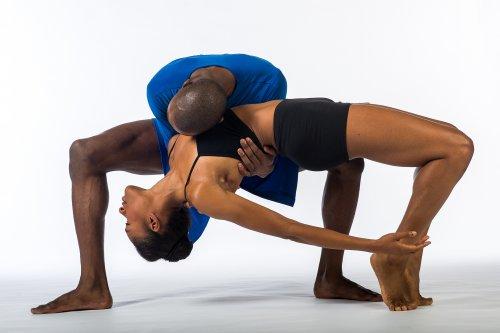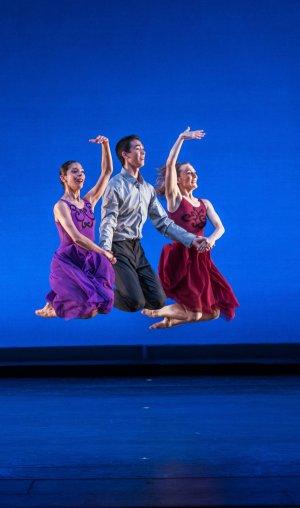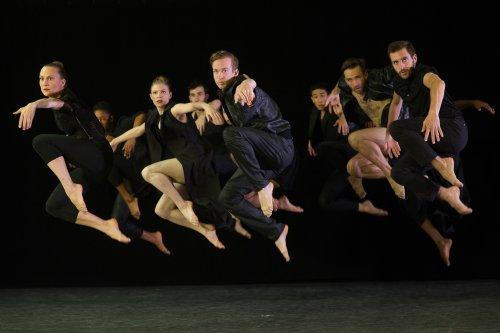Limón Dance Company: Spring 2017 Season
A valuable, historic modern dance troupe proves that it is no museum for its founders’ ballets.

Mark Willis and Kristen Foote in a scene from Limón Dance Company’s production of Kate Weare’s “Night Light” (Photo credit: Christopher Duggan)
[avatar user=”Joel Benjamin” size=”96″ align=”left” ] Joel Benjamin, Critic[/avatar]The Limón Dance Company had a week-long season at the Joyce Theater which, of course, featured choreography by one of its founders, José Limón, modern dance great and Limón muse, Doris Humphrey, as well as by two other dance makers, including a ballet by its artistic director Colin Connor.
It was interesting to compare the well-crafted, well-meant works by Limón to those by Connor and Kate Weare, two contemporary choreographers whose methods reflect—for better or worse—the let-in-all-hang-out artistic style of the current dance scene.
All three Limón works were to Baroque music. The first “Concerto Grosso,” (1945) to Vivaldi, a trio danced by Logan Frances Kruger, Kristen Foote and Ross Katen, set the pattern for subsequent Limón works on the program: clearly stated movement themes—stately walks, kneels, soft turns—performed either in unison or in a sequence moving among the dancers. Staged by former Limón dancer Risa Steinberg and beautifully lit by Christopher Chambers, “Concerto Grosso” unfolded genteelly and with clarity.

Ellen Drew, Jesse Obremski and Kathryn Alter in a scene from Limón Dance Company’s production of Limón’s “Concerto Grosso” (Photo credit: Ben Licera)
Limón’s “Chaconne,” to a J.S. Bach violin Partita is a gem. I believe “Chaconne” (1942) was originally danced by Limón himself and its stateliness must have benefited from his regal dignity. Logan Frances Kruger, dressed in elegant black high-waisted pants and a loose black shirt, went through the slow walks, bends, soft, twisty jumps and elegant turns with quiet intensity that bordered on somber. She missed the sensuousness but communicated the weightiness and meaning of the steps.
The third Limón work, staged by Kurt Douglas, was “Suite from a Choreographic Offering – for Doris Humphrey” (1964), a series of short choreographic variations on movement themes from Humphrey’s dances (many well-known to dance lovers and historians of the formative period of American modern dance). The ballet opened and closed with sections danced by the entire cast, wearing bright, solidly colored outfits (uncredited)—the first establishing full-company themes and lines of dancers spreading across the entire stage and the last full of bright, light leaps, exuberant kicks, happy lifts and a stage full of dancers whirling as the lights dimmed.
There was a beautiful duet danced by Bradley Beakes and Kristen Foote, that had quick direction changes, twisty upper body movements, generously large arm circlings, all punctuated by Ms. Foote’s sudden drop into a seated position, a pose taken directly from a Humphrey ballet, “New Dance.” A slow solo, eloquently danced by Brenna Monroe-Cook, featured tendril-like arms and soft tilts.
“Choreographic Offering” was well-danced, helped by Christopher Chambers lighting.

A scene from Limón Dance Company’s production of Colin Connor’s “Corvidae” (Photo credit: Christopher Duggan)
“Corvidae,” Colin Connor’s contribution to the program, was staged to the relentless first movement of a Philip Glass Violin Concerto. The title refers to the scientific name of the family of crows and ravens. The six dancers, stylishly dressed in all black outfits by Connor and Keiko Voltaire and moodily lit by DK Kroth, wandered about stylishly, but aimlessly, suddenly bursting into movement, softly leaping, arms held in wing-like positions. The heads of stationary dancers were held high in ornithological awareness as the rest of the cast softly cut through the air in balletic, sweeping steps. The overall mood was dark and sexy.
Kate Weare’s “Night Light” ended the program. Dressed in Fritz Masten’s dark blue shirts and black trunks, the entire company was put through their paces, often forming lines to frame duets. Same sex and male/female duets co-existed with the push and pull and lifts distributed evenly. The score, from various sources, included hard-edged violin music (Franz Biber) and electronic sounding melodies. Weare, helped by Clifton Taylor’s space-defining lighting, seemed to be coolly commenting on modern relationships, but never generated any emotional heat. Her ability to move dancers about skillfully is quite apparent, but she needs to take it to a higher expressive level.
The company is in good shape and this season augurs well for Colin Connor’s directorship.
Limón Dance Company (May 2-7, 2017)
Joyce Theater, 175 Eighth Avenue, in Manhattan
For tickets, call 212-242-0800 or visit http://www.Joyce.org
Running time: two hours including one intermission






Leave a comment